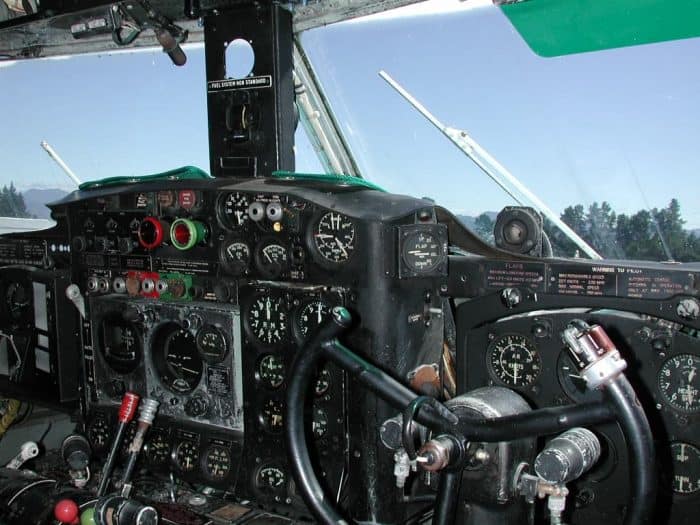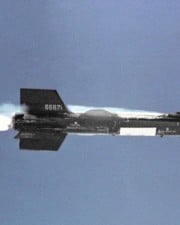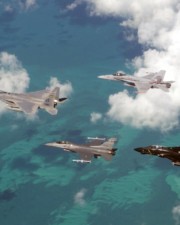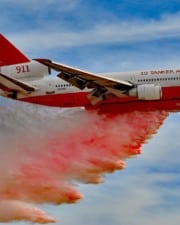Cargo planes, also known as freight planes, freighters, and even cargo jets, has a fixed wing and carries cargo instead of passengers. They are usually not operated by commercial airlines but instead, by cargo airlines, civil passenger airlines, or even the military units of various countries. They have features that distinguish them from regular airlines, and there are also many different types of cargo planes.
Cargo planes are distinctly different than other types of planes, both in their purpose and in their design. Cargo airplanes include early air mail and airlift logistics planes, civilian cargo planes, light aircraft, military cargo planes, and experimental cargo planes.
They vary in their usage, payload, and volume, and they can carry a wide variety of cargo for both civilian and military use.
More specifically, the airlines that provide these cargo planes include Boeing, Douglas, Lockheed, Airbus, Cessna, and McDonnell-Douglas, to name a few.
Interestingly, the items transported by cargo planes today vary widely and include products such as vehicles, musical instruments, weapons and ammunition, mail, retail products, toys, furniture, and even animals.
There are dozens of types of cargo planes these days, and while some of them are unfamiliar to most people, others are more well-known than you think.
1. Douglas C-133 Cargomaster

The Douglas C-133 Cargomaster was built between 1956 and 1961 and was used by the United States Air Force. It was a 157-foot airplane that carried large and heavy loads, and it consisted of large tail doors, large side doors, and a super-large cargo area.
It was replaced in the early 1970s by the C-5 Galaxy and it was a turboprop-powered strategic airlifter.

In the early years, the Cargomaster was nicknamed “the widow-maker” because of the number of crashes it had, including various crashes from 1958 to 1970.
These cargo planes are now found and stored in various places, including Wright-Patterson Air Force Base near Dayton, Ohio; Davis-Monthan Air Force Base in Tucson, Arizona; and Dover Air Force Base in Dover, Delaware.
2. EADS CASA C-295

The EADS CASA C-295 is a twin turboprop military transport aircraft and is currently manufactured in Spain. The plane underwent several upgrades in 2012 and now includes winglets and the ability to carry the Marte anti-ship missile.
The plane is in use by the military in over 15 countries, and it has variants that include the C-295M, C-295 Firefighter, CC-295 SAR, KC-295, and C-295 MP/Persuader, among others.
Some of the countries using the C-295 include Egypt, India, Canada, Mexico, the Philippines, Spain, and Vietnam, to name a few.
It is an 80-foot plane with a wingspan of 84 feet, and it has a maximum take-off weight of 51,000 lbs.
It also has a maximum speed of 358 miles per hour, or 311 knots, and its cruising speed is 300 miles per hour or 260 knots.
3. Aero Spacelines Super Guppy
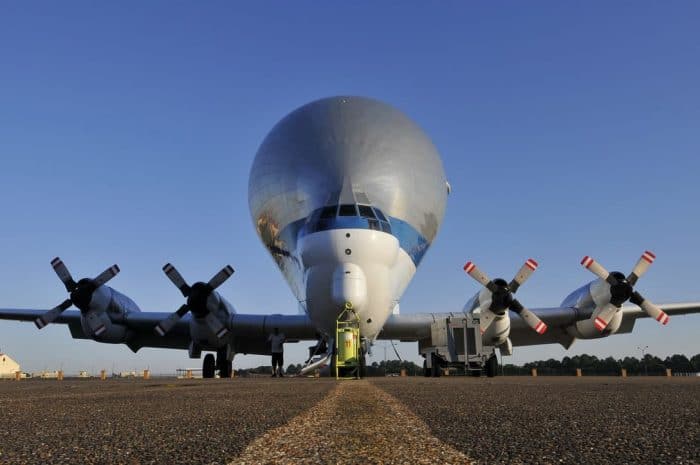
Although it is an older design – the first one was used in 1965 – the Super Guppy is NASA’s favorite for transporting spacecraft and other large objects.
It was made to carry a load of 54,000 lbs. and could still cruise at 300 miles per hour. Its second version, the Super Guppy Transport, carried 52,500 lbs. and was both wider and longer.
Today, the Aero Spacelines Super Guppy and its variants are either on display or still being used, and some of the places you can find them include Toulouse-Blagnac Airport in France, Davis-Monthan Air Force Base in Arizona, and the El Paso International Airport in Texas.
It was formerly operated by Airbus and Aeromaritime.
4. Canadair CL-44
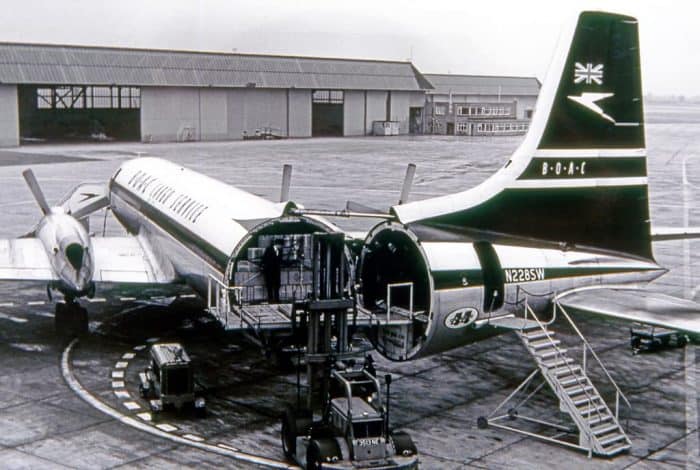
The Canadair CL-44 was one of the cargo airplanes produced by Canadair in the late 1950s to the early 1960s. They were produced for the Royal Canadian Air Force and only a small number of them were manufactured.
Named after the Canadian territory of Yukon, the CL-44 had a number of variants, including the CL-44-6, CL-44D4-8, CL-44-O, and CL-44J.
They are now being used by numerous airlines in countries such as the United States, Luxembourg, Ireland, and Colombia, to name a few.
5. Boeing 747 Dreamlifter
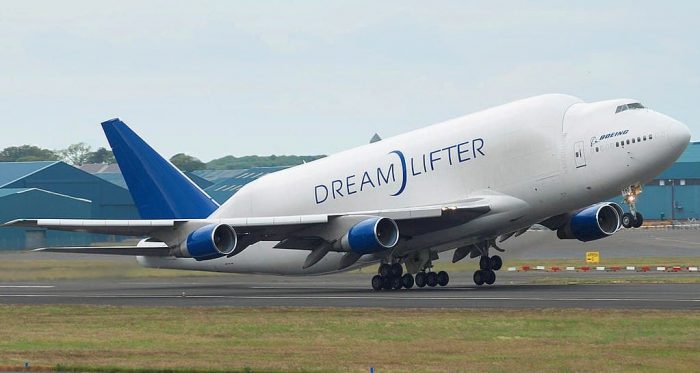
One of the world’s largest cargo planes, the Boeing 747 Dreamlifter is a variation of the Boeing 747.
Its fuselage design is made so that the plane can carry a number of very-large items, including items that are awkwardly shaped and won’t fit on other airplanes.
The 747-8 Freighter is one of its variants and is a bit heavier, having a maximum take-off weight of nearly 900,000 lbs.
6. Lockheed C-5 Galaxy
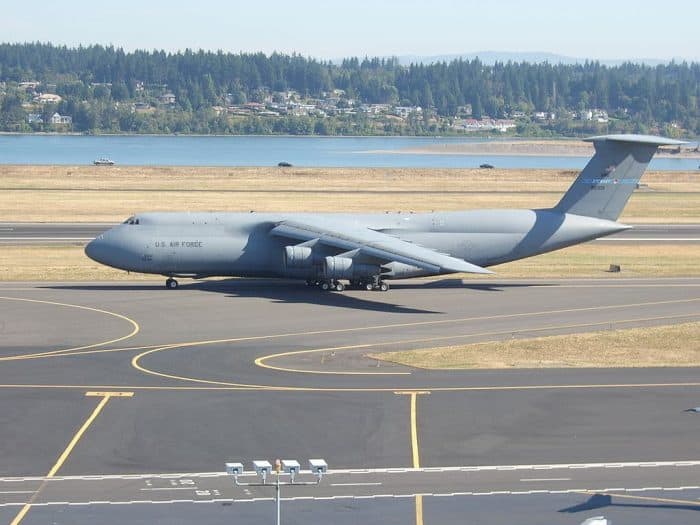
When it comes to planes currently operated by the U.S. military, the Lockheed C-5 Galaxy is the largest one.
It has a payload capacity of almost 240,000 lbs., and a variety of other very large vehicles, including 10 light armored vehicles (which weigh 12 tons each), six Apache helicopter gunships, and an entire Chinook transport helicopter, among other things.
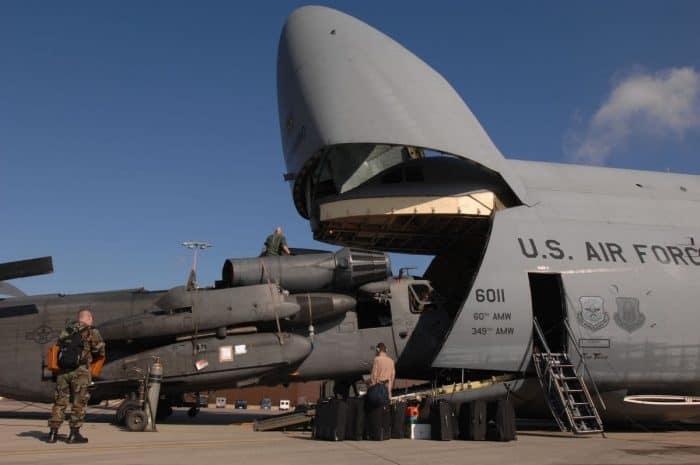
This is an enormous plane that can carry a lot of different super-big boats, planes, vehicles, and many other items.
7. Airbus A400M Atlas

This plane is operated in countries such as the United Kingdom, Germany, Spain, Turkey, and France, and it was originally built as an international project.
It flew for the first time in 2009 and uses modern composite materials for the fuselage. It also has turboprop engines that keep its operating costs low and its fuel always running efficiently. It also has a payload capacity of 74,000 lbs.

The A400M is designed to replace numerous aircraft, including the Lockheed Martin C-130 Hercules and TRANSALL C-160. It can carry 2 8×8 armored vehicles thanks to its size, and it can even take off and land on soft airfields, even those with short runways.
It can also operate with limited or no ground facilities. Some of its capabilities include aerial refueling and medical evacuation, as long as it is fitted with the right type of equipment.
8. Embraer KC-390

The Embraer KC-390 is not as large as some other cargo airplanes, being considered a medium-sized cargo plane instead. It has twin engines and is jet-powered, and it is used to transport cargo and troops, as well as for aerial refueling.
In fact, the KC-390 is able to transport up to 26 tons of cargo, and this includes wheeled armored fighting vehicles. It is also a new type of cargo plane, with its first plane being delivered in September of 2019.
For now, the two main operators are Portugal and Brazil, both of which use the planes for military operations. It is 110 feet long, has a maximum take-off weight of roughly 192,000 lbs., and has a wing span of 113 feet. It can carry 66 paratroopers, 74 stretchers, 80 troops, or 7 463L master pallets.
9. Lockheed R6V Constitution
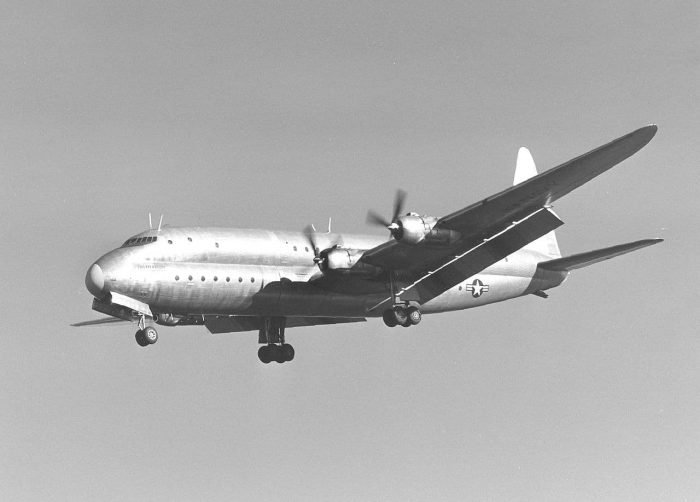
This was a large plane developed in the 1940s for use by Pan American Airways and the U.S. Navy. It was a propeller-driven airplane that was also a double-decker transport plane, and only two of them were ever built.
Both of these two planes were actually prototypes, and unfortunately the design of the plane proved underpowered and actually too big to be of any practical use.
Today, the Lockheed R6V Constitution is still the largest fixed-wing airplane that has ever been used by the U.S. Navy.
10. Kawasaki C-2
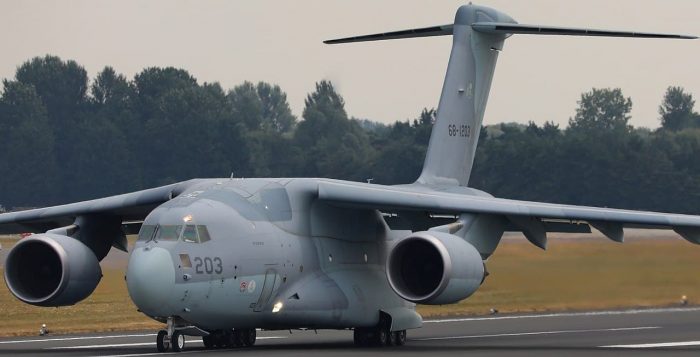
The Kawasaki C-2 (which is not the same thing as the Kawasaki C-2 motorcycle) is a mid-sized plane with twin turbofans and was developed by the Kawasaki Aerospace Company. It is a long-range, high-speed plane that the military uses to transport different items.

It was developed to replace the Kawasaki C-1 turbofan transport, which has been around since the 1970s, and there are currently efforts to sell it to countries such as the United Arab Emirates (UAE) and New Zealand.
11. Bristol Freighter

Manufactured by Bristol Aerospace Company, the Bristol Freighter was meant to be both an airliner and a freighter. It is a twin-engine aircraft and its main use was as an air ferry to carry cars and their owners to places not that far away.
It had its maiden flight in 1945 and was roughly 69 feet in length. It was formally known as the Bristol Type 170 Freighter and was designed in Britain.
12. Boeing C-17 Globemaster III

This plane is considered a true workhorse in the United States Air Force, in part because it flies regular strategic supply missions all over the world. The Boeing C-17 Globemaster was developed in the 1980s and made its last flight 11 years later in 1991.
The Lockheed C-141 StarLifter was its predecessor, and only 250 of these cargo airplanes were ever built. Today, it is used by several countries around the world and by the U.S. Air Force.
This plane has a payload capacity of over 75 tons, and it has the ability to carry three Stryker 8×8 armored vehicles, an M1A2 Abrams tank, or 3 AH-64 Apache helicopters.
It is also able to carry a mix of both vehicles and palletized cargo, and it can regularly operate from airfields which used to be denied to jet-powered planes. In fact, it can even operate from runways that are unimproved or unpaved.
Related Posts



